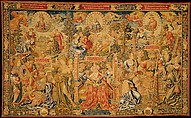The Twelve Ages of a Man: The Second Three Ages (18-36), or Summer
Probably after a design by the Workshop of Bernard van Orley Netherlandish
Not on view
This is the second in a set of four tapestries illustrating the life of a man as divided into twelve periods of six years. Ceres, in the center, stands for the summertime of life; the symbols and occupations of three months, April, May, and June, represent the years from ages 18 to 36. Ceres, Roman goddess of the harvest, is identified in a Latin elegiac distich on a scroll. The pansies and daisies of Ceres’s dress are not traditionally her flowers, and it has been suggested that they may refer here to the possible patron of this tapestry series, Margaret of Austria, Governor of the Habsburg Netherlands from 1507 until 1530. The green bird conspicuous in the composition might also have been intended as a reference to Margaret of Austria, who apparently owned a green parrot.
Each of the three vertical sections includes a roundel at the top surrounded by twenty-four hourglasses on a ground that is light above and dark below, in varied proportions, according to the seasons. Each roundel contains a sign of the zodiac, Taurus, Gemini and Cancer, and figures variously symbolizing April, May and June. The roundels are seen against the sky, which is dark blue at the top, and are flanked by winds, most with their names inscribed on their bellows or elsewhere. Below the two outer roundels are representations of the months’ occupations: gardening for April and sheep-shearing for June. Below the occupations and the center roundels are episodes from mythology and classical history illustrating protagonists associated with particular ages of a man. Under April is the sleeping youth Hercules, proving his new-found maturity by choosing Minerva and Discipline over Venus and Vice. Under May, Venus and Adonis dally. Under June, the soldier being presented with arms is identified in his banderol as "Curius", probably indicating Marcus Curius Dentatus, who was prized for refusing brides from the Samnite ambassadors, represented by the alluring maidens surrounding him. Given that he seems to be accepting the weaponry, an alternative identification sometimes suggested is that this is the triumphant young soldier Lucius Sicinius Dentatus whom, Pliny writes, was presented with arms in recognition of his bravery.
The two outer episodes have framed pairs of verses in Latin, supported by pedestals, between them and the occupation of the month above; the center episode has a similar inscription between it and the deity below. The verses refer to the story illustrated. In the upper border, on scrolls held by winged boys, are three Latin couplets connecting each month with an age in the life of a man. In the lower border, flanking the inscription below the deity, are two medallions containing an animal, bird or object. The foregrounds of all the scenes are filled with flowering and fruiting plants.
Due to rights restrictions, this image cannot be enlarged, viewed at full screen, or downloaded.

